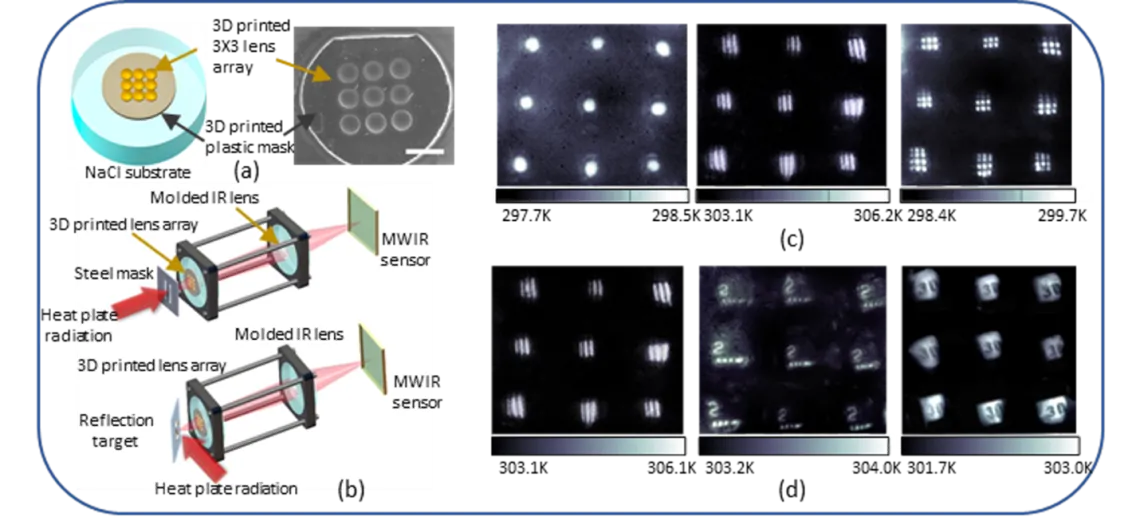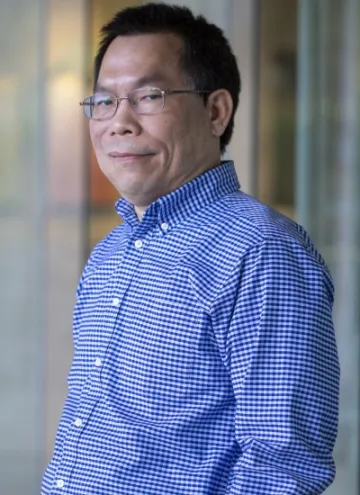Novel Materials for 3D printing in Infrared Optics : A Five Minute Review with Prof. Ron Liang

(a) Scheme of fabrication of lens array for the experiment. A 3X3 lens array was printed on a NaCl plate by two-photon polymerization using the resin prepared with tetraSH and DVO2. A polymer mask containing 3X3 holes matched to the lens array was 3D printed by a commercial digital light processing (DLP) printer and a commercial resin to block light not passing through the lens array. Scale bar: 1 mm. (b) Schemes of the imaging systems for experiments. The printed lens array and molded lens were assembled in a frame to maximize the imaging quality. Both the transmission mode (top) and reflection mode(bottom) were employed during the experiments. (c) Transmission image of steel masks with single hole (left, 5 mm diameter), vertical grille (middle, 2 mm width), and mesh grille (right, 2x2 mm for every single lattice). (d) Reflection images of USAF target (Group -2, left and middle) and a steel ruler (right) as reflection targets.
Rongguang Liang
Prof. Ron Liang's research lab encompasses not only the development of IR materials and printing techniques for optical elements but also places a significant emphasis on 3D printing of glass optics. Over recent years, their work has advanced in this field through the creation of liquid silica resin (LSR) and polymeric silsesquioxane (PSQ) resin, specifically tailored for glass optics printing.
In fact, the research lab has successfully navigated two primary challenges associated with producing high-performance, high-contrast glass imaging optics. The first challenge was multi-material printing, for which they innovated a self-welding process that facilitates the creation of multi-element glass optics. The second achievement involves perfecting a printing technique that allows for on-demand control of transparency. This advancement is particularly vital in the manufacture of high-contrast imaging systems. Below you can learn more about the process and potential impacts of this work.
How did the idea for creating this photo-curable liquid material capable of overcoming conventional limitations first occur to you as a possibility?
Previous studies on materials transparent to Long-Wave Infrared (LWIR) and Mid-Wave Infrared (MWIR) have primarily used inverse vulcanization, which involves elemental sulfur as a key reagent. This method typically requires heating to facilitate the reaction. In contrast, thiol compounds, which contain a high sulfur content, present an alternative approach. Distinct from inverse vulcanization, the thiol-ene reaction can be initiated using UV light. Investigating the use of thiol-ene reactions to create chemical structures akin to those achieved through inverse vulcanization suggests the possibility of developing UV-curable optical elements that maintain transparency at LWIR and MWIR wavelengths.
The new material is transparent across the spectrum from visible to mid-wave infrared all the way to long-wave infrared. Did you or other scientists ever believe achieving this level of transparency could be possible? What was the moment like when you realized you’d achieved your goal?
Materials developed through inverse vulcanization are known for their broadband infrared transparency. A key distinction of our system is its unique capability to be UV-cured. This feature is a first in the field, enabling the creation of complex 3D structures via 3D printing, a significant advancement in the manufacturing of optically transparent elements.
Upon successfully printing our first IR optical element using the two-photon polymerization process, we confirmed the realization of our objective: the development of novel materials specifically tailored for 3D printing in infrared optics.
What kind of applications can you imagine this new technology being applied to? What’s next!?
IR optics are pivotal in various sectors including military, medical, industrial, environmental, and astronomical applications. They are used for thermal imaging in security and surveillance, medical diagnostics through heat variation detection, industrial inspection for machinery and system health, remote sensing in environmental and agricultural monitoring, and in astronomy to observe celestial objects in the IR spectrum. In the military, IR optics are critical for night vision, target tracking, and guiding missile systems, playing a crucial role in enhancing operational capabilities.
Moving forward, we aim to enhance this technology through advancements in both material development and printing precision. Our focus will be on creating new materials that not only improve IR transparency but also offer a variable refractive index, facilitating the manufacturing of intricate optical components. Additionally, we plan to refine the printing process, aiming for higher resolution and accuracy, which is essential for superior surface quality and improved imaging performance.
More about Liang's Lab & Research
- Nature Communications publication titled "UV-curable thiol-ene system for broadband infrared transparent objects"
- Imaging and Applied Optics Lab
- Rongguang Liang's Google Scholar
- "Laser Focus World" Features Ron Liang's Research Article as Top 2022 Editor's Choice
- Ron Liang Selected for 2023 NAI Senior Member Class

More about Ron Liang
Dr. Liang’s research focuses on three major fields: biomedical imaging, advanced imaging, and optical engineering. In biomedical imaging, his lab has been working on various imaging techniques for image guided surgery, cancer detection and diagnosis, including low-cost, mobile imaging platform for oral cancer screening in low-resource setting and multimodal OCT system for precision oral cancer detection and diagnosis. His lab has also been investigating new optical techniques for tissue imaging, such as confocal, light sheet, multiphoton, and hyperspectral imaging. In advanced imaging, Dr. Liang’s lab aims to extract additional information based on phase, polarization, and spectrum. His lab has developed snapshot imaging techniques for polarization and spectral imaging. In optical engineering, Dr. Liang’s lab is known for the capabilities in optical design, fabrication, and testing. His group has been developing compact optical systems for medical, consumer, industrial, and space applications, including three cameras used in NASA’s OSIRIX-REx mission. In addition to precision diamond turning, his lab has developed unique 3D printing method for fabricating precision freeform optics. Dr. Liang’s group has also been very active on optical metrology, with a focus on freeform and snapshot metrology.
